荧光寿命测定的现代方法与应用
荧光寿命_论文-自然科学论文

荧光寿命荧光寿命( FLT)检测摘要这个技术手册介绍了荧光寿命( FLT)这种新技术的基本原理。
从这本技术手册里,我们可以简单的了解与这项技术相关的理论基础和与之配合的实验条件,以及通过一项应用实例讨论了如何对实验中所获得的数据进行解析和归类的方法。
•微孔板技术在高通量筛选中的价值使用者利用一个 marker或者是标记物受光激发后,通过一台普通的微孔板阅读器,就可以监测生化和生物反应进程。
常用的读取模式包括检测吸收光,荧光强度(FI),荧光偏振(FP),时间分辨荧光(TRF)。
一般没有方法能够包含所有可能的分析模式,如果达到这样的高分析程度,需要一个配套的方法能够覆盖尽可能宽的实验范围。
尽管如此,,还是会有一种方法被优选选择,通过它能够得到更可靠的数据,更高端的信息,以及迅速的读取数据。
荧光寿命被定义成荧光分析在回到基态之前驻留在激发态的时间。
荧光寿命对荧光标记物周围的微环境高度敏感。
当标记一个反应对,由于化学反应改变这个反应对的状态(例如在酶反应体系中)或者是发生了与其他结合伴侣的结合(例如受体 -配体的结合),将影响到上面所提到的微环境。
无论如何,检测荧光寿命将直接指示反应环境。
这类信号要远远强于通常会影响其它探测方法的干扰信号,因此它将为市场需求加入巨大的推动力。
Tecan Ultran Evolution detection platform已经融入了对荧光寿命的检测。
除了已经发展的各种检测方法以外,这项新技术使得Ultran Evolution技术平台具有更强的市场应用前景。
2.荧光寿命测定的原理用 Ultra Evolution测定荧光寿命采用的一种方法,称作时间关联的单光子计数(TCSPC)。
实验的基本流程显示在图1。
一个脉冲激光器重复激发样品。
调节激发脉冲的强度,使得对于任何一个脉冲,在探测器上只有一个光子被计数。
按照测量的激光脉冲和探测器感应之间的这段时间,将计数值引入已用荧光计数和时间绘制的柱状图。
荧光寿命测定
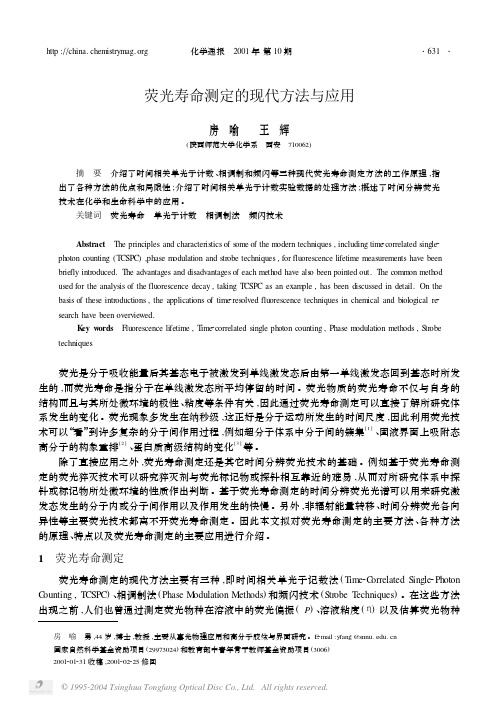
·632 ·
化学通报 2001 年 第 10 期 http :ΠΠwww. chemistrymag. org
的分子体积 ( V0 ) ,根据 Perrin 方程来计算荧光寿命[4] ,虽然这种方法所用仪器比较简单 ,但测定过
数有限 ,因此测量精度较差 。1980 年后多频相技术得到发展 ,相调制技术测定荧光寿命的精度也随之
提高 ,从而使复杂体系荧光寿命测定成为可能。但同时仪器也变得昂贵 ,实验测定难度也相应增大。
113 频闪技术[9]
频闪技术也叫脉冲取样 技 术 ( Pulse Sam2
pling Techniques) ,仪器工作原理示于图 3 ( a) 。
首先商品化 。此外 ,Edinburgh Instruments、IBH、HORIBA 等公司也在生产基于 TCSPC 的时间分辨荧
光光谱仪 。
TCSPC 的工作原理如图 1 所示 ,光源发出的脉冲光引起起始光电倍增管产生电信号 ,该信号通
过恒分信号甄别器 1 启动时辐转换器工作 ,时幅转换器产生一个随时间线性增长的电压信号 。另
除了直接应用之外 ,荧光寿命测定还是其它时间分辨荧光技术的基础 。例如基于荧光寿命测 定的荧光猝灭技术可以研究猝灭剂与荧光标记物或探针相互靠近的难易 ,从而对所研究体系中探 针或标记物所处微环境的性质作出判断 。基于荧光寿命测定的时间分辨荧光光谱可以用来研究激 发态发生的分子内或分子间作用以及作用发生的快慢 。另外 ,非辐射能量转移 、时间分辨荧光各向 异性等主要荧光技术都离不开荧光寿命测定 。因此本文拟对荧光寿命测定的主要方法 、各种方法 的原理 、特点以及荧光寿命测定的主要应用进行介绍 。
荧光测量法的原理和应用

荧光测量法的原理和应用1. 原理荧光测量法是一种利用物质在吸收光能后再辐射出更高能量的光的特性进行测量的方法。
它基于分子或原子的电子能级跃迁现象,通过激发物质中的分子或原子,使其处于激发态,然后通过发射更高能量的光来测量样品的特性。
1.1 荧光激发荧光的激发通常是通过吸收光能引起的。
当物质吸收光能时,其内部的分子或原子处于激发态,电子从基态跃迁到高能级。
此时,物质可以通过非辐射转化或荧光转化来释放能量。
荧光是短时间内释放能量的一种方式,荧光光谱是荧光转化产生的光的光谱。
1.2 荧光测量原理荧光测量法基于荧光转化产生的特征光谱,通过测量样品发射的荧光光谱,可以获得样品的相关信息。
荧光测量通常包括以下过程:1.激发:通过激发光源(通常是紫外光)激发样品中的分子或原子,使其处于激发态。
2.发射:被激发的样品会在短时间内发射荧光光子,其能量较高。
3.分析:测量样品的荧光光谱,分析样品的组成、结构或性质。
2. 应用荧光测量法在许多领域都有广泛的应用,包括生命科学、化学分析、环境监测和材料研究等。
2.1 生物学和生物化学荧光测量法在生物学和生物化学中具有重要的应用。
例如,荧光染料可以被用于标记和追踪生物分子(如蛋白质、核酸和细胞等),通过测量它们的荧光强度或荧光光谱,可以研究它们的相互作用、定位和功能。
荧光在免疫分析和基因测序中也有广泛应用。
2.2 化学分析荧光测量法在化学分析中发挥着重要的作用。
荧光染料可以被用作分析试剂,通过与待测物质发生特异性反应,生成荧光产物后进行测量。
这种方法具有灵敏度高、选择性好和操作简便等特点,常用于药物分析、环境监测和食品安全等领域。
2.3 环境监测荧光测量法在环境监测中也得到广泛运用。
荧光探针可以被用于检测环境中的污染物。
例如,利用荧光探针可以监测水体中的重金属离子、有机污染物和微生物等。
荧光测量法具有快速、灵敏度高和无损伤等特点,适用于现场监测和实时监测。
2.4 材料研究荧光测量法在材料研究中也有广泛应用。
荧光寿命测定的现代方法与应用

荧光寿命测定的现代方法与应用房 喻 王 辉(陕西师范大学化学系 西安 710062)摘 要 介绍了时间相关单光子计数、相调制和频闪等三种现代荧光寿命测定方法的工作原理,指出了各种方法的优点和局限性;介绍了时间相关单光子计数实验数据的处理方法;概述了时间分辨荧光技术在化学和生命科学中的应用。
关键词 荧光寿命 单光子计数 相调制法 频闪技术Abstract The principles and characteristics of s ome of the m odern techniques,including time2correlated single2 photon counting(T CSPC),phase m odulation and strobe techniques,for fluorescence lifetime measurements have been briefly introduced.The advantages and disadvantages of each method have als o been pointed out.The comm on method used for the analysis of the fluorescence decay,taking T CSPC as an example,has been discussed in detail.On the basis of these introductions,the applications of time2res olved fluorescence techniques in chemical and biological re2 search have been overviewed.K ey w ords Fluorescence lifetime,T ime2correlated single photon counting,Phase m odulation methods,S trobe techniques荧光是分子吸收能量后其基态电子被激发到单线激发态后由第一单线激发态回到基态时所发生的,而荧光寿命是指分子在单线激发态所平均停留的时间。
荧光寿命的名词解释

荧光寿命的名词解释在现代科学技术领域中,荧光是一种常见且重要的现象。
它源于物质受到激发后所释放出的光,其持续时间被称为荧光寿命。
本文将对荧光寿命的概念进行解释,并探讨其在科学研究和实际应用中的意义。
荧光寿命是指荧光发射的持续时间,即物质从受到外界激发到停止发射荧光的过程所需时间。
通常,荧光寿命是以时间单位表示,比如纳秒、微秒、毫秒等。
不同物质的荧光寿命可能会有较大差异,因此荧光寿命的观测和测量成为了研究荧光性质的重要手段之一。
荧光寿命的测定通常通过荧光寿命仪等专用仪器进行。
这种仪器通过激发样品,并记录发射的荧光光谱,从而得到荧光寿命数据。
荧光寿命仪的工作原理基于样品在受到激发后,激发态能级的原子或分子通过非辐射跃迁的方式回到基态能级,从而发射荧光。
荧光寿命的测量结果具有一定的物质特异性,因为不同的物质在受到激发后,其激发态能级能量差以及非辐射跃迁速率等参数会有所不同,从而影响荧光寿命的大小。
因此,荧光寿命可以作为一种物质特征或指纹,用于鉴别和区分不同物质。
荧光寿命在化学、物理、生物等学科领域中得到了广泛应用。
在药物研究中,科学家可以通过观测荧光寿命的变化,了解药物分子与目标分子相互作用的情况,从而有助于药物设计和筛选。
在材料科学领域,荧光寿命的测量可以提供材料的光学性能信息,用于材料性能改进和优化。
在环境监测中,荧光寿命可以用于检测和追踪有害物质的存在和迁移。
此外,荧光寿命还在生物医学领域具有重要意义。
通过标记生物分子或细胞结构上的荧光探针,并测量其荧光寿命,科学家可以得到有关生物过程和分子交互的信息。
这种技术被称为荧光寿命显微镜,已经成为生物学研究和临床诊断中的重要工具。
尽管荧光寿命在科学研究和实际应用中有着广泛的应用,但其测量和解释仍然面临一些挑战。
比如,荧光寿命受到环境因素的影响,如温度、溶液性质等,因此在测量过程中需要进行适当的控制和校正。
此外,荧光寿命的分析也需要考虑样品的固有特性,如荧光寿命的分布范围和多个激发态能级的存在等。
荧光寿命数据的相量分析及其应用

荧光寿命数据的相量分析及其应用*林丹樱† 牛敬敬 刘雄波 张潇 张娇 于斌 屈军乐‡(深圳大学物理与光电工程学院, 光电子器件与系统教育部/广东省重点实验室, 深圳 518060)(2020 年4 月15日收到; 2020 年5 月14日收到修改稿)荧光寿命显微成像技术(fluorescence lifetime imaging microscopy, FLIM)具有特异性强、灵敏度高、可定量测量等优点, 被广泛应用于生物医学、材料学等领域的研究. 为使FLIM技术更好地适用于高通量数据的快速分析, 近年来涌现出多种荧光寿命分析的新算法. 其中, 相量分析法(phasor analysis, PA)通过将时间域的拟合转化为频率域的直接计算来获得荧光寿命值, 与传统的最小二乘拟合法相比, 不仅更加简便快速,适用于低光子数情形, 而且便于使数据内容可视化和对数据进行聚类分析, 因此越来越受到科研人员的青睐.本文详细阐述了相量分析法的基本原理及运用方法, 并在此基础上介绍了该方法在细胞代谢状态测量、蛋白质相互作用研究、细胞微环境测量, 以及辅助病理诊断和提高超分辨成像分辨率等方面的应用, 着重讨论了PA法在这些FLIM应用实例中的优势所在, 为相关领域的研究提供有益的参考. 最后, 对荧光寿命数据的相量分析及其应用的发展方向进行展望.关键词:荧光寿命显微成像, 数据分析, 相量分析法, 生物医学应用PACS:87.64.–t, 87.64.M–, 87.64.kv, 87.85.Pq DOI: 10.7498/aps.69.202005541 引 言随着荧光标记技术的快速发展, 荧光显微成像技术已成为生物医学研究领域不可或缺的工具之一. 荧光寿命作为荧光的一个重要参量, 反映了荧光分子从激发态回到基态的退激发速率, 是荧光分子的固有特性, 其变化能非常灵敏地反映荧光分子所处微环境(如细胞微环境中的温度、黏度、pH值、离子浓度等)的变化情况[1]. 同时由于荧光寿命的测量可不受荧光探针浓度、激发光强度、光漂白等因素的影响, 相比强度测量更有利于实现定量化, 因此探测样品中荧光寿命的分布和变化的荧光寿命显微成像技术(fluorescence lifetime imaging microscopy, FLIM)常常被应用于定量测量细胞内的一些生物物理和生物化学参数[2,3], 或气溶胶的黏度测量等[4]. 另一方面, 许多荧光团分子具有相似的荧光光谱, 假如利用它们对样品中不同的结构进行特异性标记, 直接从光谱上很难分离, 但利用它们荧光寿命不同的特点, 可借助FLIM技术对其荧光进行区分, 从而实现多结构的同时标记和成像. 这些特点使得FLIM在生命科学研究中有着越来越广泛的应用.一般而言, FLIM中荧光寿命的测量方法有时域法与频域法两类, 其中频域法使用周期调制的连续光激发样品, 检测荧光信号相对激发光的振幅和相位变化来计算样品的荧光寿命; 时域法采用高重复频率的飞秒脉冲激光激发样品, 利用门控技术、* 国家重点研发计划(批准号: 2017YFA0700500)、国家自然科学基金(批准号: 61775144, 61975131, 61620106016, 61525503, 61835009)、广东省高等学校科技创新(重点)项目(批准号: 2016KCXTD007)、广东省自然科学基金(批准号: 2018A030313362)和深圳市基础研究项目(批准号: JCYJ20170818144012025, JCYJ20170818141701667, JCYJ20170412105003520)资助的课题.† 通信作者. E-mail: dylin@‡ 通信作者. E-mail: jlqu@© 2020 中国物理学会 Chinese Physical Society 扫描相机技术、时间相关单光子计数(time-correlated single photon counting, TCSPC)技术等记录脉冲过后荧光信号的衰减过程并拟合或计算荧光寿命. 因此, 不管对于哪种类型的FLIM, 荧光寿命数据的处理都是非常关键的一环. 例如, 时域法荧光寿命数据最常用的处理方法是非线性最小二乘(nonlinear least-squares, NL-LS)拟合法,即选择一种衰减模型(单指数、双指数或多指数衰减)对每个像素点的测量数据进行曲线拟合, 然后分析出各衰减组分的荧光寿命值. 但是这种方法要求衰减模型的选择要合适, 同时要求每个像素点要采集足够多的光子数(通常 >1000)才能够进行有效拟合[5]. 这就使得基于这种数据处理方法的FLIM技术在应用上受到了相应的限制. 例如, TCSPC-FLIM通常需要在激发光较弱的情况下进行成像, 以避免相邻两个脉冲之间检测到的光子数多于1而导致的光子堆积问题, 因此要求每个像素点采集足够多的光子数就需要延长采集时间, 由此带来的问题就是获得一幅荧光寿命图像的时间相对较长, 成像速度受限, 无法应用于一些荧光寿命变化速度较快的场合.因此, 针对这些问题, 研究者们开发出了其他的算法, 例如相量分析(phasor analysis, PA)[6]、极大似然估计(maximum likelihood estimate, MLE)[7]、一阶矩(the first moment, M1)[8]、贝叶斯分析(Bayesian analysis, BA)[9]、压缩感知(compressed sensing, CS)[10]等, 这些方法可通过降低寿命分析对光子数的要求从而间接地提高FLIM技术的成像速度[11]. 其中, PA法通过将时域信息变换到频域, 可直接计算得到荧光寿命值,简单快速, 无需拟合, 且在低光子数情况下也能得到比较准确的寿命值, 适合于快速FLIM成像. 另一方面, PA法生成的相量图能将具有相似荧光衰减特性的荧光团分子所对应的像素点显示在相邻区域, 形成一定的簇状分布, 这种特点使得利用该方法可以更方便地对数据进行可视化和聚类分析,因此结合PA法的FLIM技术(phasor-FLIM)越来越受到科研人员的青睐, 在生命科学和生物医学研究中应用越来越广泛.本文首先详细阐述phasor-FLIM的基本原理及使用方法, 并在此基础上介绍该技术应用于细胞代谢状态测量、蛋白质相互作用研究、细胞微环境测量以及辅助病理诊断和提高超分辨成像分辨率等方面的最新研究进展, 最后对其发展前景进行展望.2 Phasor-FLIM的基本原理如前所述, FLIM技术中荧光寿命的测量通常分为频域法和时域法[1,6]. 这两种方法在数学意义上互为傅里叶变换, 但它们获取荧光寿命信息的方式不同, 得到的数据内容和形式不同, 从而数据处理方法一般也不同. 频域法一般使用正弦调制的连续光激发样品, 测量得到的是具有相同频率的荧光信号, 但由于荧光寿命的影响, 荧光信号的振幅和相位相比激发光均发生了变化, 因此通过计算荧光信号相对激发光的振幅调制度变化和相位延迟可计算得到荧光寿命. 而时域法则需要采用高重复频率的飞秒脉冲激光激发样品, 利用前面提到的门控技术、扫描相机或TCSPC技术等直接或间接记录脉冲过后的荧光衰减过程, 得到的是荧光强度(或光子数)随时间的变化关系, 因此一般可通过曲线拟合得到荧光寿命.PA法最先被用于处理频域FLIM技术得到的荧光寿命数据, 其相量由频域FLIM测量得到的解调系数和相位延迟来构建, 是原始数据的直接表达[12]. PA法同样适用于时域FLIM数据的分析,但需要先将时域的荧光衰减变换到频域. 由于时域FLIM中的TCSPC-FLIM目前应用最为广泛,因此PA法在该技术中的应用也是报道得最多的.以下分别介绍这两类技术中PA法分析荧光寿命的基本原理, 并结合荧光相量图的特点阐述其典型的应用思路.2.1 频域法FLIM及其相量分析在频域FLIM中, 激发光常采用正弦调制的连续光源, 如激光、氙灯、LED灯等, 激发光强可描述为其中E(0)和E(t)分别为起始时刻和t时刻的激发光强度, M E = a/A为激发光的强度调制度(a和A分别是激发光的振幅和平均强度, 如图1(a)所示), w为调制的角频率. 利用该激发光激发标记有荧光团的样品后, 所检测到的荧光也是正弦调制的, 且其频率与激发光相同, 但强度调制度会降低,相位也有一定延迟. 如果荧光衰减符合单指数衰减规律, 则荧光光强可描述为相应地, I (0)和I (t )分别为起始时刻和t 时刻的荧光强度, M F = b /B 为荧光的强度调制度(b 和B 分别是荧光的振幅和平均强度, 如图1(a)所示), f 为相位延迟或相移. 通过测量相移f 和解调系数M = MF /M E , 即可计算出相应的荧光寿命, 即:可以证明[12,13], 当荧光的衰减过程符合单指数衰减规律(即I (t ) = I (0)e –t /t , t 为寿命)时, (3)式和(4)式算得的寿命t f 和t m 是相等的, 理论上只需要计算其中一个即可. 但假如荧光的衰减过程是两个或多个单指数衰减过程的组合(即双指数衰减或多指数衰减), 则情况更加复杂, 通常需要先在不同调制频率w i 下重复测量多组f i 和M i , 并通过以下公式先计算出等效相移和解调系数再求解寿命, 即:其中f i 为第i 个调制频率测得的光强占总光强的比例.1984年, Jameson 等[13]利用相量的概念对频域法FLIM 得到的数据进行几何表示, 他们利用单个像素点对应的解调系数M 和相移f 来构建一个相量, 即以M 作为该相量的模, 以f 作为该相量的辐角, 则可以认为相量与像素点是一一对应的, 相量图上一个相量的端点就代表了一个像素点的全部荧光寿命信息(如图1(b)所示). 该相量在实轴和虚轴的分量可用Weber 符号表示[14], 即:对于单指数衰减情形, 由(3)式和(4)式可得到cos f = M , 因此可以得到:即以坐标(G , S )表示的相量端点被约束在圆心位于(0.5, 0)处、半径为0.5的半圆上. 半圆上的每个点表示不同的寿命, 寿命值从左到右递减, 其中(1, 0)表示接近零的寿命, (0, 0)表示无限长的寿命, 如图1(b)所示.I (t )=I (0)∑jαj e −t /τj 而如果一个像素点处的荧光衰减过程为多个单指数衰减过程的叠加(即 ,其中t j 表示第j 个单指数衰减组分的寿命, a j 表示该组分的占比), 则根据衰减组分间的线性叠加性质, 其在相量图上对应的相量端点应位于半圆以内[15], 即多指数衰减过程对应的G 和S 应为:1C o u n t s Arrival time(b)(a)(d)(c)图 1 荧光寿命的测量方法及相量分析(PA)法示意图 (a)频域法测量原理示意图; (b)单指数衰减的寿命相量示例图; (c)双指数衰减的寿命相量示例图; (d)时间相关单光子计数(TCSPC)测量原理示意图Fig. 1. Schematic diagram of fluorescence lifetime measurement and phasor analysis (PA): (a) Frequency domain method; (b) life-time phasor of single-exponential decay; (c) lifetime phasor of bi-exponential decay; (d) time-correlated single photon counting (TC-SPC) method.几何意义上, 多指数衰减过程对应的相量端点应位于其各个单指数衰减组分对应的寿命相量端点连接组成的集合内. 如图1(c)中, 双指数衰减过程对应的寿命相量端点(蓝色)落在半圆以内, 位于两个单指数衰减组分对应的寿命相量端点(绿色)的连线上, 且与两端点的距离(p 1, p 2)由两个组分的占比(a 1, a 2)决定.2.2 时域法FLIM 及其相量分析PA 法同样适用于时域法FLIM 数据的分析.这里以目前应用最广泛的TCSPC-FLIM 技术为例. 如图1(d)所示, TCSPC 将每一次脉冲信号作为一个信号周期, 每个周期内当探测到第一个荧光光子时就在其到达时间对应的时间通道中进行计数, 经过多次累积即可建立一个反映荧光衰减过程的光子数-时间分布直方图, 用于求解荧光寿命.2008年, Digman 等[16]将Weber [14]于1981年提出的荧光脉冲响应的傅里叶分析方法用于TCSPC 技术, 并使用以下关系式计算相量端点坐标, 也可以将每个像素的全部荧光衰减信息转换为相量图上的单个点, 即:其中G (w )和S (w )分别是荧光脉冲响应傅里叶频谱的实部和虚部, 这里用作寿命相量的两个分量;I (t )是脉冲过后t 时刻的荧光光强, w 是脉冲激光的角频率, T 是周期长度(实际可取动态范围),n 是谐波的阶次, 一般情况下取基频分量, 即n =1. 因为TCSPC 是在N 个离散的时间通道t k 中记录荧光衰减分布直方图的, 因此上述积分运算可转化为求和计算:其中C k 是第k 个时间通道记录的光子数,I =∑Nk=1C k 是所有时间通道记录的总光子数.如果荧光脉冲响应呈单指数衰减规律, 则代入(11)式可得G (w )和S (w )与荧光寿命t 的关系为:可以验证, G , S 仍然满足(8)式的关系, 即单指数衰减情形下以坐标(G , S )表示的相量端点仍被约束在圆心位于(0.5, 0)处、半径为0.5的半圆上, 与频域法得到的相量图一致.而如果荧光脉冲响应是呈多指数衰减的, 则同样根据线性叠加关系可知, 坐标(G , S )表示的相量端点也位于半圆以内, 其中双指数衰减过程对应的相量端点也在其两个单指数衰减组分对应的相量端点连线上, 与频域法得到的结论一致.2.3 相量图的特点及其典型应用思路如前所述, 对于满足单指数衰减规律的情形,荧光寿命相量图上以坐标(G , S )表示的相量端点被约束在圆心位于(0.5, 0)处、半径为0.5的半圆上, 而多指数衰减过程的相量端点则位于半圆以内, 具体地说, 是位于各单指数衰减组分相量端点连接组成的集合内. 例如, 对于双指数衰减情形,其寿命相量端点位于两个单指数衰减组分相量端点的连线上, 且位置与两个组分的占比有关. 相量图的这些特点, 使得其在荧光寿命数据的定量分析、可视化和聚类分析方面有很大优势.如前所述, 荧光寿命反映的是荧光分子从激发态回到基态的退激发速率, 因此当处于激发态的荧光分子所处的微环境不同, 或者荧光分子与其他分子发生相互作用和能量转移时, 荧光寿命会发生灵敏的变化. 所以, 许多荧光团存在两个甚至两个以上的衰减速率, 分别对应于荧光团的不同状态, 例如细胞内的还原型烟酰胺腺嘌呤二核苷酸(nicotinamide adenine dinucleotide, NADH)处于自由态时(主要位于细胞质中)的荧光寿命为几百皮秒(t 1), 与蛋白质绑定后处于结合态时(主要位于线粒体中)的荧光寿命则达到几纳秒(t 2)[6].2005年Brid 等[17]利用干扰NADH/NAD+比例的代谢药物氰化钾(Potassium cyanide, KCN)阻断细胞的呼吸作用, 证明了细胞中自由态和结合态NADH 的占比与NADH / NAD+比例有关, 从而提出利用FLIM 测量自由态和结合态NADH 的比例, 来间接获得活细胞内的NADH/NAD+比例.NADH 与其氧化形式NAD+作为生物体内许多氧化还原反应的辅酶参与生命活动并相互转化, 它们之间的平衡反映了氧化磷酸化和糖酵解的比率, 因此NADH/NAD+比例及其变化可用于监测细胞代谢方式的变化. 对于细胞内NADH/NAD+比例的探测, 传统的方法有酶循环法、毛细管电泳法、质谱分析法等, 但这些方法只适用于对细胞提取物进行检测. 直接对细胞内NADH/NAD+比例进行探测也可以采用荧光强度成像的方法, 这是因为NADH 发荧光而NAD+不发荧光. 但由于荧光团浓度的不均一性以及自由态和结合态NADH 荧光量子产率的不同, 基于强度成像的NADH/NAD+测量结果通常存在较大误差. Brid 等[17]的工作为定量监测活细胞内NADH/NAD+的比例提供了一种新的思路, 即通过FLIM 定量测量自由态和结合态NADH 的比例来间接获得NADH/NAD+比例. 他们的研究还表明, 当NADH/NAD+比例发生变化时, 自由态和结合态NADH 的荧光寿命值(即t 1和t 2)几乎保持恒定, 变化的是它们各自的占比(即a 1和a 2). 多指数衰减情形的寿命相量与其各个单指数衰减组分寿命相量之间的线性关系,使得采用了PA 法分析荧光寿命的phasor-FLIM 特别适合于在已知单指数衰减组分寿命的前提下, 对多组分尤其是双组分中不同组分的占比进行定量分析. 所以, phasor-FLIM 的典型应用之一, 就是根据寿命相量端点的位置对NADH 两种寿命组分的占比进行定量分析, 从而用于细胞代谢状态的测量[18−27].此外, 在利用荧光共振能量转移(fluorescence resonance energy transfer, FRET)对蛋白质相互作用进行研究的FLIM-FRET 实验, 以及一些利用FLIM 研究细胞微环境参量变化的场合, 也会涉及到双指数衰减甚至多指数衰减及其组分占比的变化, 因此phasor-FLIM 在这些应用中的报道近几年也多了起来[28−34].其次, PA 法生成的相量图中, 具有相似荧光衰减特征的像素点所对应的相量端点会显示在相近的位置, 因而形成一定的簇状分布(如图2(a)和图2(b)所示), 称为“相量簇”. 同一个相量簇对应于具有相似荧光衰减特性的多个像素点, 但这些像素点在样品中的分布可以是不连续的, 和它们的空间分布并没有直接联系. 利用该特点, 可在相量图上选取感兴趣的相量簇, 并通过其对应关系找到相量簇中各相量端点所对应的像素点在样品上的位置, 就可以方便地将样品中具有相似荧光寿命特征的区域标记出来(如图2(c)所示), 还可以进一步对这些荧光寿命特征相似的区域进行聚类分析, 从而为研究一些生物医学问题带来极大的便利[18−20].倘若对不同的相量簇对应的像素点赋以不同的伪彩色, 则利用该方法还可以方便地实现荧光寿命图像的多色显示(如图2(d)所示), 从而起到辅助病理判断等作用[35−37]. 最近, 这种利用PA 法对荧光寿命的分布进行聚类分析的方法还被应用于辅助提高基于受激辐射耗尽(stimulated emission depletion, STED)的超分辨成像的分辨率[38−40].综上, 目前phasor-FLIM 的应用可以用图3来表示. 以下将举例说明phasor-FLIM 的应用研究进展.Fluorescence intensity image Lifetime phasor plotPhasor -mapped FLIM image Phasor analysis(d)(c)图 2 Phasor-FLIM 的应用思路示意图 (a)包含未处理寿命信息的荧光强度图; (b)经PA 法分析得到的寿命相量图; (c)对寿命相量直接进行分析; (d)通过相量聚类分析和伪彩色标记得到的荧光寿命图Fig. 2. Schematic diagram of phasor-FLIM application:(a) Fluorescence intensity image with untreated lifetime in-formation; (b) lifetime phasor plot obtained by PA analysis;(c) direct analysis of lifetime phasors; (d) phasor-mapped FLIM image based on phasor clustering analysis and pseudo-color assignment.3 Phasor-FLIM的应用研究进展3.1 基于NADH的细胞代谢应用研究细胞的能量主要来自细胞呼吸, 正常细胞或正常分化的细胞在有氧条件下采用糖酵解进行代谢,缺氧条件下通过氧化磷酸化进行代谢. 而高度增殖的细胞(如癌细胞或干细胞)即使在氧气充足的条件下也多选择糖酵解作为主要的产能方式, 这种现象被称为“Warburg效应”[41]. 而这种细胞代谢方式的不同导致两者所含NADH的浓度和状态存在差异. 因此基于前面提到的NADH处于两种不同状态具有不同荧光寿命的特性, 以NADH作为内源荧光标志物的双光子FLIM成像常被用于研究正常细胞、干细胞、癌细胞以及其他疾病发生时细胞的代谢差异, 而结合了PA法的phasor-FLIM 可方便地实现活组织中单细胞代谢表型的观测, 在细胞分化和增殖、疾病的机理研究和诊断等方面均具有很好的应用前景, 目前也取得了一些重要的应用研究进展.细胞分化和增殖过程会改变糖酵解和氧化磷酸化之间的平衡, 所以代谢变化可用于研究细胞分化和增殖状态. Stringari等[18−20]通过对细胞内包括NADH在内的各种内源性荧光标志物进行FLIM成像, 并利用PA法对FLIM图像进行分割,可以区分胶原蛋白、视黄醇、视黄酸, 以及处于自由态和结合态的NADH. 他们对小肠进行双光子FLIM成像并对利用PA法得到的寿命相量簇进行聚类分析, 用来识别高度增殖的小肠干细胞, 通过代谢状态对小肠干细胞和分化的后代进行分类分析, 以监测与代谢变化相关的生理(病理)过程.Lee等[21]对白细胞和白血病细胞进行FLIM成像,因为白血病细胞快速增殖, 糖酵解占主导地位, 寿命相量簇向短寿命方向移动, 利用PA法定量分析自由态和结合态NADH比例的变化, 可从血液中快速筛选和分离白血病细胞. 与传统的生物分子诊断技术相比, 这种基于phasor-FLIM的单细胞筛查方法对细胞友好, 具有临床筛选血液细胞的潜力. 细胞外基质(extracellular matrix, ECM)是所有组织必不可少的动态组成部分, 并通过提供机械和生化信号来直接影响细胞行为. ECM的变化可以改变组织的动态平衡, 从而潜在地促进细胞转化和肿瘤的发生. Romero-Lopez等[22]将正常细胞接种在提取自正常人结肠和转移至肝脏的结肠肿瘤的ECM中, 利用phasor-FLIM技术定量分析了自由态和结合态NADH的比例, 结果发现接种在肿瘤ECM中的细胞比接种在正常ECM中的细胞具有更高的游离NADH水平, 糖酵解速率较高, 表明ECM在癌细胞及其相关脉管系统的生长中起到了重要作用.由于许多疾病的发病机制与细胞代谢也有着密切的关联, phasor-FLIM在疾病的机理研究及诊断方面也有不少应用实例. 例如, 亨廷顿病(Huntington’s disease, HD)是一种常染色体神经退行性疾病, 能量代谢障碍是HD的主要发病机制. Sameni等[23]使用phasor-FLIM来定量测量HD中自由态和结合态NADH的比例变化, 作为活细胞代谢变化的间接测量, 用以研究HD发病机制, 结果表明HD的代谢障碍为糖酵解增加, 导致氧化应激和细胞死亡. 这种定量分析的方法可用于筛选HD组织并进行潜在的药物筛选, 对诊断和治疗疾病具有重要意义. 阿兹海默症(Alzheimer’sPhasor-FLIMMetabolism FRET Microenvironment Pathology p-STED BoundNADH (OXPHOS)FreeNADH(Glycolysis)Low FRETHigh FRETDonorMeasuredAutofluoresencepH 7.8pH 5.4Structure 1SelectedAbandoned图 3 Phasor-FLIM 的应用分类示意图Fig. 3. Application classification diagram of phasor-FLIM.disease, AD)是一种老年人多发的神经退行性疾病, 与抗氧化保护降低和线粒体功能障碍有关.Dong 等[24,25]使用双光子激发FLIM 技术结合PA 法定量分析了老年小鼠海马区神经元游离NADH 的水平, 结果发现随着年龄的增加, 游离的NADH 浓度降低, 氧化磷酸化占据主导地位,AD 进一步恶化, 而还原性治疗可恢复老年小鼠及AD 小鼠神经元中游离NADH 的水平. Hato 等[26]则采用类似的方法对活体小鼠肾脏进行双光子FLIM 成像, 使用PA 法分析肾脏中的代谢变化,提供了一种研究肾脏疾病代谢的方法. Datta 等[27]通过双光子FLIM 对人诱导多能干细胞分化的心肌细胞(human induced pluripotent stem cell-derived cardiomyocytes, hiPS-CMs)进行成像, 检测缺氧和线粒体毒性药物氰化钾病理刺激下代谢状态的变化. 如图4所示, 缺氧状态下和用药物刺激时hiPS-CMs 的寿命相量分布向自由态NADH 的方向移动, 代谢方式转变为糖酵解. 这种非侵入性成像技术有助于研究心脏病的发病机理和治疗方法[27].3.2 基于FLIM-FRET 的蛋白互作研究当一个荧光分子(供体)的荧光发射光谱与另一个荧光分子(受体)的激发光谱相重叠, 且两者间的距离合适(一般为6—10 nm)时, 供体的激发能诱发受体发出荧光, 同时其自身的荧光强度发生衰减, 称为FRET 效应. 由于该效应发生的程度(即FRET 效率)与供体和受体的距离紧密相关,该效应常被用于研究蛋白质间的相互作用(简称“蛋白互作”). 具体的做法是将供体荧光分子和受体荧光分子分别标记于两个蛋白质分子上, 通过测量FRET 效率来反映两个蛋白质之间的距离, 从而反映其是否发生相互作用以及相互作用的程度.从荧光寿命的角度看, 当FRET 效应发生时, 由于供体将能量转移到受体上, 供体的荧光寿命将变短. 考虑到FLIM 测量不受光漂白等因素的影响,利用FLIM 进行FRET 效率的测量比测量荧光强度变化的方法要更加准确, 因此FLIM-FRET 已被广泛应用于蛋白互作的研究. 发生和不发生FRET(或者说FRET 效率很高和很低)两种状态下供体的寿命可认为是不变的, 相当于两个单指数衰减组分, 因此根据PA 法的分析, 两种状态下得到的寿命相量应位于半圆上. 而当部分供体发生FRET 时, 总体的荧光衰减满足双指数衰减规律,寿命相量端点将位于上述两个单组分寿命相量端点的连线上, 且到两端的距离与两种组分的占比有关, 由此可方便地计算出FERT 效率. 2012年和2013年, Hinde 等[28,29]利用phasor-FLIM 和FRET 监测了小G 蛋白与RBD 蛋白在溶血磷脂酸(lysophosphatidic acid, LPA)刺激下相互作用的变化, 结果表明, 在荧光强度图像看不出明显差异的情况下, FLIM 图像和PA 定量分析均显示小G 蛋白与RBD 蛋白的标签蛋白EPCF 和Critine 在LPA 刺激下FRET 效率显著增加(如图5所示). Lou 等[30]在共表达H2B-eGFP 和H2B-mCherryrry 两种荧光蛋白的Hela 细胞中利用phasor-FLIM 测得的FRET 效率对核小体的紧实度进行了量化, 用于定量反应DNA 的损伤情况.Cell 1Cell 2Cell 2Cell 1NADH FLIM map Fluorescence intensity U n t r e a t e d c e l l sT r e a t e d c e l l sABBound NADHFree NADHPhasor distribution1.00.5000.5 1.0AB LDH-bound NADHFree NADH in solution图 4 Phasor-FLIM 用于分析细胞在缺氧和线粒体毒性药物氰化钾刺激下NADH/NAD+比例的变化, 研究代谢状态的转变[27]Fig. 4. Phasor-FLIM was used to analyze the change of NADH/NAD+ ratio under the stimulation of hypoxia and mitochondrial toxic drug potassium cyanide, for studying the change of metabolic state of cells [27].。
时间相关单光子计数法测量荧光寿命-2011
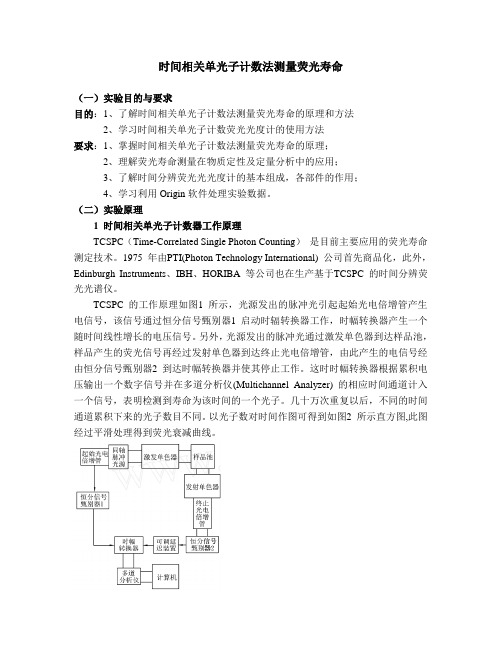
时间相关单光子计数法测量荧光寿命(一)实验目的与要求目的:1、了解时间相关单光子计数法测量荧光寿命的原理和方法2、学习时间相关单光子计数荧光光度计的使用方法要求:1、掌握时间相关单光子计数法测量荧光寿命的原理;2、理解荧光寿命测量在物质定性及定量分析中的应用;3、了解时间分辨荧光光光度计的基本组成,各部件的作用;4、学习利用Origin软件处理实验数据。
(二)实验原理1 时间相关单光子计数器工作原理TCSPC(Time-Correlated Single Photon Counting)是目前主要应用的荧光寿命测定技术。
1975 年由PTI(Photon Technology International) 公司首先商品化,此外,Edinburgh Instruments、IBH、HORIBA 等公司也在生产基于TCSPC 的时间分辨荧光光谱仪。
TCSPC 的工作原理如图1 所示,光源发出的脉冲光引起起始光电倍增管产生电信号,该信号通过恒分信号甄别器1 启动时辐转换器工作,时幅转换器产生一个随时间线性增长的电压信号。
另外,光源发出的脉冲光通过激发单色器到达样品池,样品产生的荧光信号再经过发射单色器到达终止光电倍增管,由此产生的电信号经由恒分信号甄别器2 到达时幅转换器并使其停止工作。
这时时幅转换器根据累积电压输出一个数字信号并在多道分析仪(Multichannel Analyzer) 的相应时间通道计入一个信号,表明检测到寿命为该时间的一个光子。
几十万次重复以后,不同的时间通道累积下来的光子数目不同。
以光子数对时间作图可得到如图2 所示直方图,此图经过平滑处理得到荧光衰减曲线。
图1 TCSPC 的工作原理简图图2 时间相关单光子计数2 荧光寿命及其含义假定一个无限窄的脉冲光(δ函数) 激发n 0个荧光分子到其激发态,处于激发态的分子将通过辐射或非辐射跃迁返回基态。
假定两种衰减跃迁速率分别为Γ和k nr ,则激发态衰减速率可表示为)()()(t n k dtt dn nr +Γ-= 其中n (t ) 表示时间t 时激发态分子的数目,由此可得到激发态物种的单指数衰减方程。
荧光寿命和光催化

荧光寿命和光催化荧光寿命和光催化是化学领域中两个重要的概念。
荧光寿命是指荧光分子从激发态返回基态所需的时间,而光催化是指利用光能促使化学反应发生的过程。
本文将分别介绍荧光寿命和光催化的概念、原理、应用以及未来发展方向。
一、荧光寿命1.1概念荧光寿命是指荧光分子由激发态返回基态所需的平均时间。
在分子受到激发光的照射后,电子跃迁到高能级激发态,随后再以荧光辐射的形式返回基态。
荧光寿命可以作为荧光物质的特征性质,对于分子结构的研究和应用具有重要意义。
1.2原理荧光寿命的测定是通过观察荧光分子在激发态和基态之间跃迁的过程来实现的。
一般采用激光或者其他光源对样品进行激发,然后测量荧光发射的时间延迟,通过分析发射光的强度随时间的衰减曲线,可以得到荧光寿命的信息。
1.3应用荧光寿命具有广泛的应用价值,包括但不限于生物医学领域的分子探针、荧光成像技术、环境监测、材料科学等方面。
在生物医学领域,荧光寿命的测定可以用于分子标记和细胞成像,具有很好的生物相容性和生物标记度。
1.4发展方向随着技术的不断进步,荧光寿命的测定方法也在不断完善。
近年来,单分子荧光寿命成像技术逐渐成为研究热点,可以实现对单个分子的实时观测,为生物学研究提供了新的手段。
未来,荧光寿命的精确测定和应用将更加广泛和深入。
二、光催化2.1概念光催化是指利用光能来促进化学反应的过程。
通过选择合适的光催化剂和反应条件,可以实现一系列重要的化学转化,如光解水制氢、光催化氧化还原反应等。
2.2原理光催化的原理涉及到光生电子激发、电子转移和反应物质的吸附等多个方面。
一般来说,光催化反应需要两个步骤:光生电子-空穴对的产生和电子-空穴对的利用。
光生电子-空穴对可以通过光照射材料表面激发得到,之后通过电子转移反应参与到催化反应中。
2.3应用光催化在环境净化、化学合成、能源转化等领域具有广泛的应用前景。
例如,光催化技术可以用于大气污染物的降解、有机废水的处理、光催化水解制氢等方面。
flim 荧光寿命用途

flim 荧光寿命用途荧光寿命是指荧光物质在受到激发后,从激发态返回基态所需的时间。
荧光寿命是一种重要的物理特性,具有广泛的应用价值。
本文将介绍荧光寿命的定义、测量方法和在不同领域的应用。
一、荧光寿命的定义和测量方法荧光寿命是荧光物质从激发态退激回基态所需要的时间,它是荧光物质的一个固有性质。
荧光寿命的测量通常使用荧光寿命仪进行,该仪器可以通过测量荧光物质的光强随时间的变化来获得荧光寿命数据。
荧光寿命仪利用激光或其他光源激发荧光物质,然后通过检测荧光物质发射的荧光光强来确定荧光寿命。
二、荧光寿命的应用1. 生物医学研究领域荧光寿命在生物医学研究中有着广泛的应用。
例如,在分子生物学中,荧光寿命可以用于研究荧光标记的分子在细胞中的运动和相互作用。
荧光寿命还可以用于研究细胞内的代谢活动和分子结构的变化,如DNA的损伤修复和蛋白质的折叠过程等。
此外,荧光寿命还可以用于研究荧光染料在生物组织中的分布和代谢途径,从而为荧光成像提供了重要的信息。
2. 材料科学领域荧光寿命在材料科学领域也有着重要的应用。
例如,在半导体材料中,荧光寿命可以用于研究材料的光致发光性质和载流子寿命。
荧光寿命还可以用于研究荧光材料的光学性能和电子结构,从而为材料的设计和应用提供指导。
3. 环境监测领域荧光寿命在环境监测领域也有着重要的应用。
例如,在水质监测中,荧光寿命可以用于研究水中有机物质的来源和分解途径。
荧光寿命还可以用于研究大气颗粒物中的有机污染物和气溶胶物质,从而为环境保护和治理提供重要的数据支持。
4. 光电子学领域荧光寿命在光电子学领域也有着重要的应用。
例如,在光通信领域,荧光寿命可以用于研究光纤和光器件的光学性能和信号传输特性。
荧光寿命还可以用于研究光电器件的发光机制和光电转换效率,从而为光电子技术的发展提供重要的参考。
总结:荧光寿命作为荧光物质的一个重要特性,在生物医学、材料科学、环境监测和光电子学等领域都有着广泛的应用。
荧光寿命计算公式
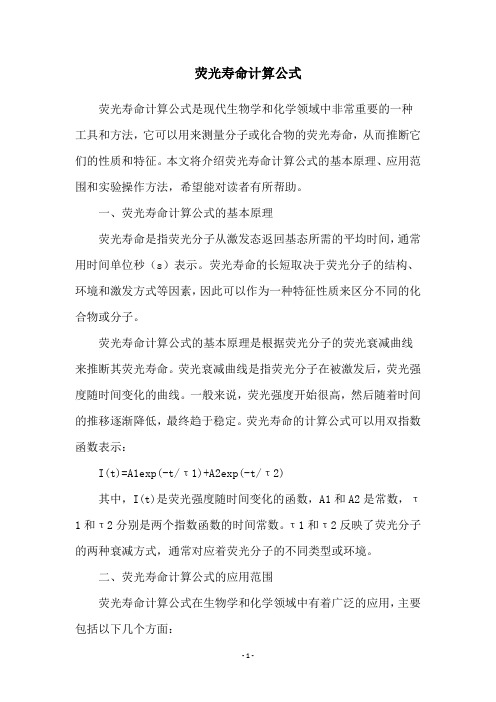
荧光寿命计算公式荧光寿命计算公式是现代生物学和化学领域中非常重要的一种工具和方法,它可以用来测量分子或化合物的荧光寿命,从而推断它们的性质和特征。
本文将介绍荧光寿命计算公式的基本原理、应用范围和实验操作方法,希望能对读者有所帮助。
一、荧光寿命计算公式的基本原理荧光寿命是指荧光分子从激发态返回基态所需的平均时间,通常用时间单位秒(s)表示。
荧光寿命的长短取决于荧光分子的结构、环境和激发方式等因素,因此可以作为一种特征性质来区分不同的化合物或分子。
荧光寿命计算公式的基本原理是根据荧光分子的荧光衰减曲线来推断其荧光寿命。
荧光衰减曲线是指荧光分子在被激发后,荧光强度随时间变化的曲线。
一般来说,荧光强度开始很高,然后随着时间的推移逐渐降低,最终趋于稳定。
荧光寿命的计算公式可以用双指数函数表示:I(t)=A1exp(-t/τ1)+A2exp(-t/τ2)其中,I(t)是荧光强度随时间变化的函数,A1和A2是常数,τ1和τ2分别是两个指数函数的时间常数。
τ1和τ2反映了荧光分子的两种衰减方式,通常对应着荧光分子的不同类型或环境。
二、荧光寿命计算公式的应用范围荧光寿命计算公式在生物学和化学领域中有着广泛的应用,主要包括以下几个方面:1.生物分子的荧光测量。
荧光寿命可以用来测量生物分子(如蛋白质、核酸等)的结构和活性,从而研究生物分子的功能和机制。
2.药物筛选和评价。
荧光寿命可以用来评价药物分子的亲和力、稳定性和毒性等性质,从而为药物筛选和设计提供重要依据。
3.材料科学和光电子学。
荧光寿命可以用来研究材料的光学性质和电子传输机制,从而为材料科学和光电子学的研究提供重要工具。
三、荧光寿命计算公式的实验操作方法荧光寿命计算公式的实验操作方法主要包括以下几个步骤:1.实验样品的制备。
根据具体的应用需要,选取合适的荧光分子或生物分子,制备样品溶液或固体样品。
2.荧光衰减曲线的测量。
将样品置于荧光光源下,记录荧光强度随时间变化的曲线。
长寿命荧光探针的设计和应用研究

长寿命荧光探针的设计和应用研究荧光探针是一种被广泛应用于化学、生物学、医学以及物理学等领域的重要工具。
荧光探针能够利用化学或生物学系统的特殊性质来实现特定的信号转换,从而直观地观察生命过程中特定分子的运动和变化。
荧光探针的发展一直是各个领域研究的热点,其中之一就是长寿命荧光探针的设计和应用研究。
一、长寿命荧光探针的设计长寿命荧光探针的设计是指设计一种荧光探针,其荧光寿命较长,一般为微秒至毫秒级别。
与传统的荧光探针相比,长寿命荧光探针具有以下优点:1. 长寿命荧光探针具有强烈的荧光信号,信号比传统的荧光探针强几十到上百倍。
2. 长寿命荧光探针的荧光寿命长,能够减少样品的背景荧光干扰,提高检测的精度和灵敏度。
3. 长寿命荧光探针的光稳定性好,能够减少光伤害对样品的影响。
常见的长寿命荧光探针有:1. 氧合铁卟啉(oxygenated hemin):氧合铁卟啉被称为“长寿命荧光探针之王”,其荧光寿命长达100微秒级别。
氧合铁卟啉的荧光强度随着氧气的浓度变化,可以广泛应用于生命科学和材料科学等领域。
2. 金属-有机骨架(Metal-Organic Frameworks,MOF):MOF材料具有高孔隙度、大比表面积和可调性等特点,可以作为长寿命荧光探针。
例如,Zr(IV)-based MOF(UiO-66)可用于检测水分子,其荧光寿命长达40毫秒级别。
3. 聚合物(Polymers):聚合物荧光探针已成为一种热门的研究领域,其荧光强度高、光稳定性好、容易操作等特点使其成为广泛应用的荧光探针之一。
例如,聚苯乙烯具有长荧光寿命、良好的发光效率和很好的生物相容性,其可以作为生物标记物和细胞成像剂。
二、长寿命荧光探针的应用随着科学技术的发展,长寿命荧光探针的应用也越来越广泛。
以下是长寿命荧光探针在不同领域的应用:1. 生命科学:长寿命荧光探针可以广泛应用于生物学研究中,例如分子探测、蛋白质追踪和细胞成像等方面。
例如,金属-有机骨架可以用于细胞成像,可以实现对细胞的高分辨率成像,从而研究细胞的分子动态和生物过程。
2021新荧光寿命测定方法专业资料

一、荧光寿命的概念
自发辐射跃迁的过程是一种只与原子本身的性质有关,与辐射场无关的自 发过程。A21的大小与原子处在E2能级上的平均寿命τ2有关。 E2能级上的粒子数密度n2随时间的变化率
dn2(t)/dt=-(dn21/dt)sp=-A21n2(t) n2(t)= n2(0)e -A21n2(t)
E4
(10-8s) E4
E3
(10-3s) E3
h
E2
E2
E级E2的原子自发地向低能级E1跃迁,并发射出一个频 率为
υ=( E2- E1 )/h的光子。 自发跃迁几率:发光材料在单位时间内,从高能级上产生自发辐射的发光 粒子数密度占高能级总粒子数密度的比值
光子q重概率密度则变成单个光电子概率密度:
三二一、、、时 测 荧间定光其相荧寿关光命中单寿的I光命概0子的念是计几数种时方方间法法T为CSP零C 时的荧光强I (度t)。=于I0 是ex,p荧( 光- t/寿τ)命定义为衰减总速率的倒数: τ = (Γ + knr ) - 1
也就是说荧光强度衰减到初始强度的1/e 时所需要的时间就是该荧光物质 在测定条件下的荧光寿命。
荧光寿命测定方法
一、荧光寿命的概念 二、测定荧光寿命的几种方法 三、时间相关单光子计数方法TCSPC 四、TCSPC技术优缺点 五、荧光寿命测定中可能存在的问题
一、荧光寿命的概念
激光(Laser)的全名是“光的受激辐射放大”。
(Light Amplification by Stimulated Emission of Radiation)
三、单光子计数方法
• 单光子计数技术,是检测极微弱光的有力手段,这一技术是通过 分辨单个光子在检测器(PMT)中激发出来的光电子脉冲,把光 信号从热噪声中以数字化的方式提取出来
测荧光寿命实验报告(3篇)
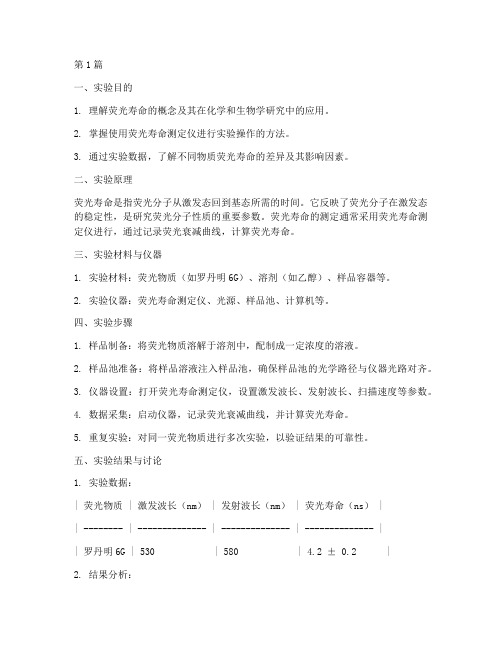
第1篇一、实验目的1. 理解荧光寿命的概念及其在化学和生物学研究中的应用。
2. 掌握使用荧光寿命测定仪进行实验操作的方法。
3. 通过实验数据,了解不同物质荧光寿命的差异及其影响因素。
二、实验原理荧光寿命是指荧光分子从激发态回到基态所需的时间。
它反映了荧光分子在激发态的稳定性,是研究荧光分子性质的重要参数。
荧光寿命的测定通常采用荧光寿命测定仪进行,通过记录荧光衰减曲线,计算荧光寿命。
三、实验材料与仪器1. 实验材料:荧光物质(如罗丹明6G)、溶剂(如乙醇)、样品容器等。
2. 实验仪器:荧光寿命测定仪、光源、样品池、计算机等。
四、实验步骤1. 样品制备:将荧光物质溶解于溶剂中,配制成一定浓度的溶液。
2. 样品池准备:将样品溶液注入样品池,确保样品池的光学路径与仪器光路对齐。
3. 仪器设置:打开荧光寿命测定仪,设置激发波长、发射波长、扫描速度等参数。
4. 数据采集:启动仪器,记录荧光衰减曲线,并计算荧光寿命。
5. 重复实验:对同一荧光物质进行多次实验,以验证结果的可靠性。
五、实验结果与讨论1. 实验数据:| 荧光物质 | 激发波长(nm) | 发射波长(nm) | 荧光寿命(ns) || -------- | -------------- | -------------- | -------------- || 罗丹明6G | 530 | 580 | 4.2 ± 0.2 |2. 结果分析:根据实验数据,罗丹明6G的荧光寿命为4.2 ± 0.2 ns。
结果表明,罗丹明6G在激发波长为530 nm、发射波长为580 nm的条件下,荧光寿命相对稳定。
3. 影响因素:荧光寿命受到多种因素的影响,如温度、溶剂、荧光物质浓度等。
在本实验中,荧光寿命的稳定性主要得益于实验条件的一致性。
六、实验总结通过本次实验,我们掌握了荧光寿命测定仪的使用方法,了解了荧光寿命的概念及其在化学和生物学研究中的应用。
长寿命荧光探针的设计及应用
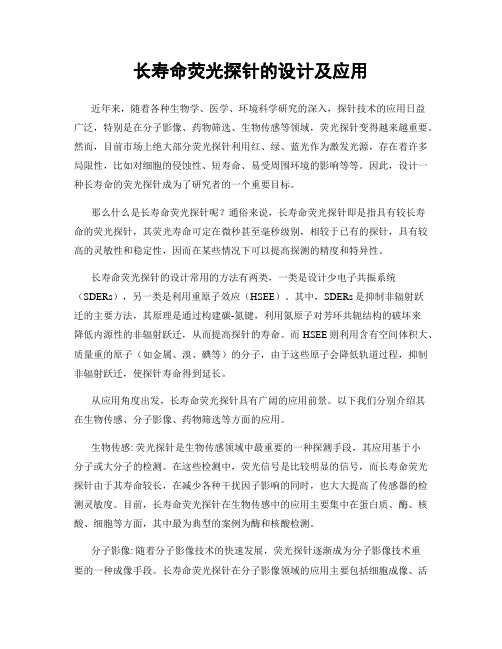
长寿命荧光探针的设计及应用近年来,随着各种生物学、医学、环境科学研究的深入,探针技术的应用日益广泛,特别是在分子影像、药物筛选、生物传感等领域,荧光探针变得越来越重要。
然而,目前市场上绝大部分荧光探针利用红、绿、蓝光作为激发光源,存在着许多局限性,比如对细胞的侵蚀性、短寿命、易受周围环境的影响等等。
因此,设计一种长寿命的荧光探针成为了研究者的一个重要目标。
那么什么是长寿命荧光探针呢?通俗来说,长寿命荧光探针即是指具有较长寿命的荧光探针,其荧光寿命可定在微秒甚至毫秒级别,相较于已有的探针,具有较高的灵敏性和稳定性,因而在某些情况下可以提高探测的精度和特异性。
长寿命荧光探针的设计常用的方法有两类,一类是设计少电子共振系统(SDERs),另一类是利用重原子效应(HSEE)。
其中,SDERs是抑制非辐射跃迁的主要方法,其原理是通过构建碳-氮键,利用氮原子对芳环共轭结构的破坏来降低内源性的非辐射跃迁,从而提高探针的寿命。
而HSEE则利用含有空间体积大、质量重的原子(如金属、溴、碘等)的分子,由于这些原子会降低轨道过程,抑制非辐射跃迁,使探针寿命得到延长。
从应用角度出发,长寿命荧光探针具有广阔的应用前景。
以下我们分别介绍其在生物传感、分子影像、药物筛选等方面的应用。
生物传感: 荧光探针是生物传感领域中最重要的一种探测手段,其应用基于小分子或大分子的检测。
在这些检测中,荧光信号是比较明显的信号,而长寿命荧光探针由于其寿命较长,在减少各种干扰因子影响的同时,也大大提高了传感器的检测灵敏度。
目前,长寿命荧光探针在生物传感中的应用主要集中在蛋白质、酶、核酸、细胞等方面,其中最为典型的案例为酶和核酸检测。
分子影像: 随着分子影像技术的快速发展,荧光探针逐渐成为分子影像技术重要的一种成像手段。
长寿命荧光探针在分子影像领域的应用主要包括细胞成像、活细胞成像以及体内小动物成像等方面。
其中,最为典型的案例为长寿命荧光标记的纳米颗粒在细胞和整个体内的分布状况的实时动态成像。
光荧长寿命选取灵活方法改进初步考虑杂乱影响因素
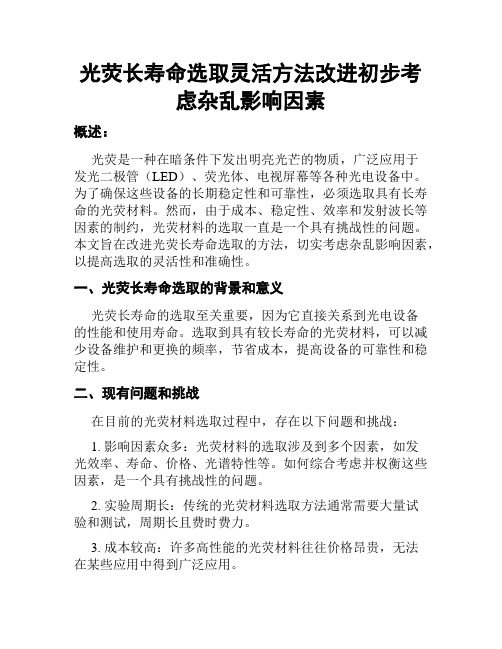
光荧长寿命选取灵活方法改进初步考虑杂乱影响因素概述:光荧是一种在暗条件下发出明亮光芒的物质,广泛应用于发光二极管(LED)、荧光体、电视屏幕等各种光电设备中。
为了确保这些设备的长期稳定性和可靠性,必须选取具有长寿命的光荧材料。
然而,由于成本、稳定性、效率和发射波长等因素的制约,光荧材料的选取一直是一个具有挑战性的问题。
本文旨在改进光荧长寿命选取的方法,切实考虑杂乱影响因素,以提高选取的灵活性和准确性。
一、光荧长寿命选取的背景和意义光荧长寿命的选取至关重要,因为它直接关系到光电设备的性能和使用寿命。
选取到具有较长寿命的光荧材料,可以减少设备维护和更换的频率,节省成本,提高设备的可靠性和稳定性。
二、现有问题和挑战在目前的光荧材料选取过程中,存在以下问题和挑战:1. 影响因素众多:光荧材料的选取涉及到多个因素,如发光效率、寿命、价格、光谱特性等。
如何综合考虑并权衡这些因素,是一个具有挑战性的问题。
2. 实验周期长:传统的光荧材料选取方法通常需要大量试验和测试,周期长且费时费力。
3. 成本较高:许多高性能的光荧材料往往价格昂贵,无法在某些应用中得到广泛应用。
4. 可靠性有限:部分光荧材料的性能可能在长时间使用后发生变化,从而导致设备的性能和稳定性下降。
三、改进方法为解决上述问题,改进光荧长寿命选取的方法应考虑以下因素:1. 综合因素权衡:在选取光荧材料时,应综合考虑发光效率、寿命、价格、光谱特性等因素,并根据应用需求设置优先级。
这样可以在不同的应用场景下选择最合适的光荧材料,提高选取的灵活性。
2. 实验与模拟结合:采用实验与模拟相结合的方法,可以减少实验周期,提高选取效率。
通过建立光荧材料的性能模型,利用计算机仿真和模拟技术,预测光荧材料的性能,并优化选取方案。
3. 考虑价格与性价比:在选取光荧材料时,不仅应考虑其性能,还要综合考虑价格与性价比。
高性能的光荧材料往往价格昂贵,而一些性能相对较低的光荧材料可能具有更好的性价比,可以得到更广泛的应用。
荧光寿命测定的现代方法与应用PPT文档共27页

6
,
天
高
风
景
澈
。
7、翩翩新 来燕,双双入我庐 ,先巢故尚在,相 将还旧居。
8
、
吁
嗟
身
后
名
,
于
我
若
浮
烟
。
9、 陶渊 明( 约 365年 —427年 ),字 元亮, (又 一说名 潜,字 渊明 )号五 柳先生 ,私 谥“靖 节”, 东晋 末期南 朝宋初 期诗 人、文 学家、 辞赋 家、散
▪
29、勇猛、大胆和坚定的决心能够抵得上武器的精良。——达·芬奇
▪
30、意志是一个强壮的盲人,倚靠在明眼的跛子肩上。——叔本华
谢谢!
27
文 家 。汉 族 ,东 晋 浔阳 柴桑 人 (今 江西 九江 ) 。曾 做过 几 年小 官, 后辞 官 回家 ,从 此 隐居 ,田 园生 活 是陶 渊明 诗 的主 要题 材, 相 关作 品有 《饮 酒 》 、 《 归 园 田 居 》 、 《 桃花 源 记 》 、 《 五 柳先 生 传 》 、 《 归 去来 兮 辞 》 等 。
1
0
、
倚
南
窗
以
寄
傲
,
审
容
膝
之
易
安
。
▪
26、要使整个人生都过得舒适、愉快,这是不可能的,因为人类必须具备一种能应付逆境的态度。——卢梭
▪
27、只有把抱怨环境的心情,化为上进的力量,才是成功的保证。——罗曼·罗兰
▪
28、知之者不如好之者,好之者不如乐之者。——孔子
荧光寿命测定的现代方法与应用PPT共27页

51、没有哪个社会可以制订一部永远 适用的 宪法, 甚至一 条永远 适用的 法律。 ——杰 斐逊 52、法律源于人的自卫本能。——英 格索尔
53、人们通常会发现,法律就是这样 一种的 网,触 犯法律 的人, 小的可 以穿网 而过, 大的可 以破网 而出, 只有中 等的才 会坠入 网中。 ——申 斯通 54、法律就是法律它是一座雄伟的大 夏,庇 护着我 们大家 ;它的 每一块 砖石都 垒在另 一块砖 石上。 ——高 尔斯华 绥 55、今天的法律未必明天仍是法律。 ——罗·伯顿
1、最灵繁的人也看不见自己的背脊。——非洲 2、最困难的事情就是认识自己。——希腊 3、有勇气承担命运这才是英雄好汉。——黑塞 4、与肝胆人共事,无字句处读书。——周恩来 5、阅读使人充实,会谈使人敏捷,写作使人精确。——培根
Байду номын сангаас
仪器计算的荧光寿命

仪器计算的荧光寿命荧光寿命是一项重要的仪器计算指标,它用于描述物质从激发态退激到基态所需的时间。
这个概念在化学、物理、生物等领域都有着广泛的应用。
下面我将以人类视角,用简洁而生动的语言,为大家介绍荧光寿命的相关知识。
荧光寿命,顾名思义,就是物质从受激发后到退激回基态所经历的时间。
这个过程可以类比为人类的一生,从出生到离世的过程。
每个物质的荧光寿命都是独一无二的,就像每个人的人生都是独特的一样。
荧光寿命的计算是依靠先进的仪器设备完成的。
仪器会通过激发物质,并记录物质退激的时间。
这个过程需要高精度的计时器和灵敏的探测器来保证测量的准确性。
仪器计算的荧光寿命可以帮助科研人员了解物质的性质和行为,进而指导科研工作的进行。
荧光寿命的值通常用纳秒(ns)或皮秒(ps)来表示。
这个值越大,说明物质从激发态退激到基态所需的时间越长,荧光寿命越长。
相反,如果荧光寿命很短,说明物质退激回基态的速度很快。
荧光寿命的长短与物质的分子结构、环境条件等有关。
不同的物质具有不同的分子结构,因此其荧光寿命也会有所不同。
同时,荧光寿命还受到温度、溶剂、化学反应等外部条件的影响。
这些因素会改变物质的能级结构和退激速率,从而影响荧光寿命的数值。
荧光寿命的计算对于科研工作具有重要的意义。
它可以帮助科学家了解物质的光谱性质、能级结构以及分子间的相互作用。
在生物医学领域,荧光寿命的测量可以用于细胞成像、药物筛选等应用。
在材料科学领域,荧光寿命的研究可以帮助科学家设计出更高效的荧光材料。
荧光寿命是一项重要的仪器计算指标,它反映了物质从激发态退激到基态所需的时间。
荧光寿命的计算需要先进的仪器设备,并受到物质的分子结构和外部条件的影响。
荧光寿命的研究对于科学研究和应用具有重要的意义。
通过仪器计算的荧光寿命,科学家可以更好地了解物质的性质和行为,推动科学进步。
荧光分子平均寿命

荧光分子平均寿命荧光分子平均寿命,是指一个荧光分子从被激发到发出荧光的平均时间。
荧光分子的平均寿命对于荧光检测和生命科学等领域有着重要的作用。
一、荧光分子的发光机制荧光分子的发光机制为激发态荧光分子自发辐射,由于辐射跃迁的速率很慢,因此需要经过一个时间才能发出荧光。
这个时间就是荧光分子的平均寿命。
二、测量荧光分子平均寿命的方法常用的测量荧光分子平均寿命的方法为荧光寿命仪。
荧光寿命仪可以通过激发荧光分子发出荧光,并通过荧光图像观察荧光分子的发光强度随时间的变化,从而得出荧光分子的平均寿命。
三、荧光分子平均寿命的作用1. 用于荧光检测荧光分子的平均寿命可以用于荧光检测中,通过测量荧光分子的平均寿命来确定样品中特定的分子或细胞结构的存在和分布情况。
2. 用于生命科学研究荧光分子的平均寿命可以用于生命科学研究中,通过测量荧光分子的平均寿命来确定细胞活性、分子动力学和分子相互作用等生物学过程的信息。
3. 用于荧光探针的设计荧光分子的平均寿命可以用于设计荧光探针,通过调节荧光分子的平均寿命来改变荧光探针的灵敏度和选择性。
四、如何控制荧光分子的平均寿命1. 通过改变荧光分子的化学结构。
例如,改变荧光分子的取代基和共轭结构可以影响荧光分子的平均寿命。
2. 通过改变荧光分子的环境条件。
例如,改变溶液的pH值和温度可以影响荧光分子的平均寿命。
五、结论荧光分子平均寿命是荧光分子发光机制的一个重要参数,通过测量荧光分子的平均寿命可以获得生物学世界中的许多重要信息。
在实际应用中,需要根据具体情况来选择荧光分子的平均寿命,或者通过控制环境条件和改变荧光分子的化学结构来控制荧光分子的平均寿命。
荧光寿命测定的现代方法与应用PPP文档(最全版)

实际测定得到的荧光衰减曲线N ( tk )是仪器响应函数L ( tk )和真实荧光衰减函数I ( t )的卷积。
子间作用过程,例如超分子体系中分子间的簇集、固液界面 但是这种方法所用仪器结构复杂、价格昂贵、而且测定速度慢,无法满足某些特殊体系荧
By the turn of the twenty-first century, the field of fluorescence microscopy was responsible for a revolution in cell biology, coupling the power of
By the turn of the twenty-first century, the field of fluorescence microscopy was responsible for a revolution in cell biology, coupling the power of live cell imaging to highly specific multiple labeling of individual organelles and macromolecular complexes with synthetic and genetically encoded fluorescent probes.
荧光寿命测定的现代 方法与应用
- 1、下载文档前请自行甄别文档内容的完整性,平台不提供额外的编辑、内容补充、找答案等附加服务。
- 2、"仅部分预览"的文档,不可在线预览部分如存在完整性等问题,可反馈申请退款(可完整预览的文档不适用该条件!)。
- 3、如文档侵犯您的权益,请联系客服反馈,我们会尽快为您处理(人工客服工作时间:9:00-18:30)。
荧光寿命的概念
荧光是分子吸收能量后其基态电子S0被激发到单线激发
态S1或S2后由第一单线激发态S1回到基态S0时所发生的。
荧光寿命是指分子在单线激发态 S1所平均停留的时间,
或者说处于激发态S1的分子数目衰减到原来的1/e所经历的 时间。
由于荧光现象多发生在纳秒级,这正好是分子运动所发生 的时间尺度,因此利用荧光技术可以“看”到许多复杂的分 子间作用过程,例如超分子体系中分子间的簇集、固液界面 上吸附态高分子的构象重排、蛋白质高级结构的变化等。
时间相关单光子记数法(Time-Correlated Single-Photon
In the 1920s and 1930s Jabłoński investigated polarized light and fluorescence and was able to show that the transition moments in absorption and emission are two different things.
七彩的荧光
主要内容
• 荧光及荧光分光光度计的发展 • 荧光寿命的基本原理 • 荧光寿命测定的现代方法及数据处理 • 测定荧光寿命的一些应用 • 测定荧光寿命的仪器
The Development of Fluorescence
The emission of light from any substance is called luminescence. Some of the first scientific reports of luminescence appeared in the middle of the 18th century.
By the turn of the twenty-first century, the field of fluorescence microscopy was responsible for a revolution in cell biology, coupling the power of live cell imaging to highly specific multiple labeling of individual organelles and macromolecular complexes with synthetic and genetically encoded fluorescent probes.
The Development of Fluorescence Microscopes
The first fluorescence microscopes were developed between 1911 and 1913 by German physicists Otto Heimstt and Heinrich Lehmann as a spin-off from the ultraviolet instrument.
Basic theory of fluorescence Lifetime
The photophysical processes that occur from absorption to emission are often shown in a so-called Jabłoński diagram.
时间相关单光子记数法(Time-Correlated Single-Photon
Counting , TCSPC)
TCSPC 的工作原理如图所示
电
荧光
信
号
Hale Waihona Puke 累积电压信号停止工作
电信号
时间相关单光子记数法(Time-Correlated Single-Photon
Counting , TCSPC)
以光子数对时间作图可得到如图所示的直方图,此 图经过平滑处理得到荧光衰减曲线。
时间相关单光子记数法(Time-Correlated Single-Photon
Counting , TCSPC)
TCSPC 是目前主要应用的荧光寿命测定技术, 1975 年由PTI (Photon Technology International) 公司首先商品化。此外,Edinburgh Instruments、 IBH、HORIBA 等公司也在生产基于TCSPC 的时间 分辨荧光光谱仪。
In 1845, Herschel observed that an otherwise colourless solution of quinine (quinine absorbs in the UV region) in water emitted a blue colour under certain circumstances.
It wasn't until the early 1940s that Albert Coons developed a technique for labeling antibodies with fluorescent dyes, thus giving birth to the field of immunofluorescence.
荧光寿命测定的现代方法
荧光寿命测定的现代方法主要有以下几种,即时间相关 单光子记数法(Time-Correlated Single-Photon Counting , TCSPC) 、频闪技术(Strobe Techniques)、相调制法 (Phase Modulation Methods) 、条纹相机法(Streak Cameras) 和上转换法(Upcon-version Methods)。
